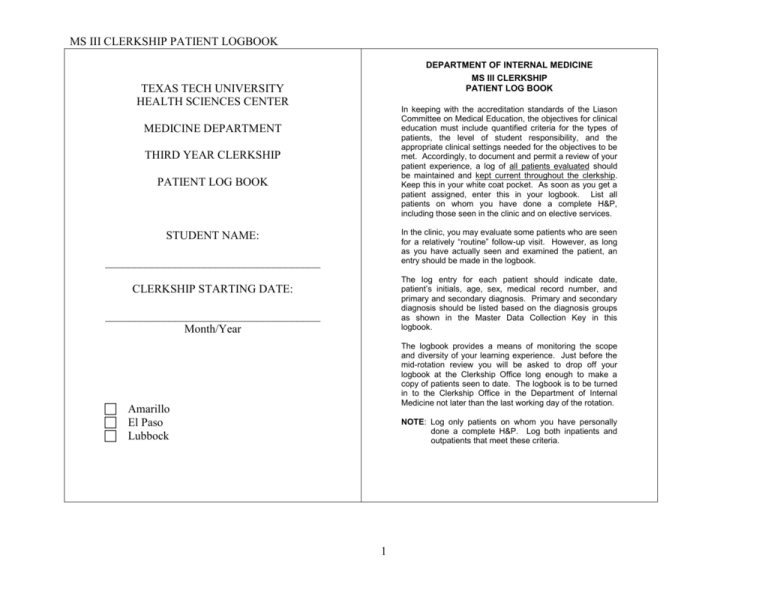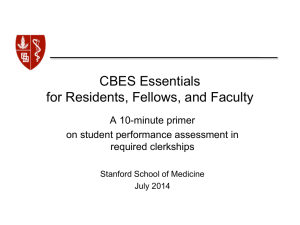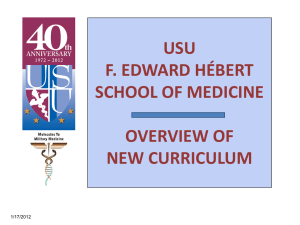Third Year Clerkship Patient Log - Texas Tech University Health
advertisement

MS III CLERKSHIP PATIENT LOGBOOK DEPARTMENT OF INTERNAL MEDICINE MS III CLERKSHIP PATIENT LOG BOOK TEXAS TECH UNIVERSITY HEALTH SCIENCES CENTER In keeping with the accreditation standards of the Liason Committee on Medical Education, the objectives for clinical education must include quantified criteria for the types of patients, the level of student responsibility, and the appropriate clinical settings needed for the objectives to be met. Accordingly, to document and permit a review of your patient experience, a log of all patients evaluated should be maintained and kept current throughout the clerkship. Keep this in your white coat pocket. As soon as you get a patient assigned, enter this in your logbook. List all patients on whom you have done a complete H&P, including those seen in the clinic and on elective services. MEDICINE DEPARTMENT THIRD YEAR CLERKSHIP PATIENT LOG BOOK In the clinic, you may evaluate some patients who are seen for a relatively “routine” follow-up visit. However, as long as you have actually seen and examined the patient, an entry should be made in the logbook. STUDENT NAME: _____________________________________ The log entry for each patient should indicate date, patient’s initials, age, sex, medical record number, and primary and secondary diagnosis. Primary and secondary diagnosis should be listed based on the diagnosis groups as shown in the Master Data Collection Key in this logbook. CLERKSHIP STARTING DATE: _____________________________________ Month/Year The logbook provides a means of monitoring the scope and diversity of your learning experience. Just before the mid-rotation review you will be asked to drop off your logbook at the Clerkship Office long enough to make a copy of patients seen to date. The logbook is to be turned in to the Clerkship Office in the Department of Internal Medicine not later than the last working day of the rotation. Amarillo El Paso Lubbock NOTE: Log only patients on whom you have personally done a complete H&P. Log both inpatients and outpatients that meet these criteria. 1 MS III CLERKSHIP PATIENT LOGBOOK Master Data Collection Key Patient Logbook Review Internal Medicine Patient LogBook Diagnosis Groups Applicable to Patients Seen by Clinical Clerks in Amarillo, El Paso, and Lubbock The patient logbook will be reviewed and patients seen summarized by diagnosis groups during the mid rotation evaluation and at the end of the clerkship in the table below. This reflects the number of patients seen by category. The results of this review will be totaled in the summary chart below. For an explanation of the disease categories, see the Master Data Collection Key on the next page. (Note: Diagnostic Groups are listed in bold followed by abbreviations used on charts) Cardiovascular CV Chest Pain (including CAD/MI) CHF Arrhythmia Hypertension Shock Thrombophlebitis/DVT Other (Specify) Respiratory RESP COPD (including acute exacerbation) Asthma Pneumonia Pulmonary embolus Other (specify) As you go through your clerkship, you should keep this logbook current and review it frequently with your ward and clinic attendings and residents. While there are no specific maximum numbers of patients for each category, you should have a minimum of at least one patient in each category and aim for a reasonably balanced distribution. This will compliment your core curriculum lectures and facilitate development of a good Internal Medicine fund of knowledge. Renal/Genitourinary Disease RENAL In general, you should average at least three patients per week. Thus, you will be able to evaluate 30 or more patients during a 12-week medicine clerkship. ARF CRF Transplant Stone Other (specify) Infectious Diseases ID AIDS Sepsis UTI/Urosepsis Cellulitis Other (specify) Patient/Diagnosis Summary Diagnosis Group Mid-Rotation Tabulation Total End-Rotation Tabulation Total CV RESP RENAL ID GI ENDO RHEUM HEM/ONC NEURO GEN TOTAL Gastrointestinal GI G.I. Bleed (upper or lower) Diarrhea (any cause) Liver disease Pancreatitis Ascites Other (specify) 2 Endocrine ENDO Diabetes DKA Thyroid disease Adrenal disease Other (specify) Rheumatology RHEUM Arthritis Vasculitis Lupus/SLE Other (specify) Hematology/Oncology HEM/ONC Anemia Thrombocytopenia Coagulopathy Other (specify) Neurology NEURO Stroke/CVA Syncope/Dizziness Epilepsy Drug overdose Other (specify) General areas GEN Drug problem Dermatological problem Psychiatric problem Alcohol problem Pain Testing/Diagnostic evaluation Other (specify) MS III CLERKSHIP PATIENT LOGBOOK PT. INITIALS AGE/SEX MED.RECORD# DATE PRIMARY DIAGNOSIS PT. INITIALS AGE/SEX MED.RECORD# SECONDARY DIAGNOSIS 3 DATE PRIMARY DIAGNOSIS SECONDARY DIAGNOSIS MS III CLERKSHIP PATIENT LOGBOOK Procedures Developed by the Clerkship Directors in Internal Medicine: The Goals and Objectives for the Internal Medicine Clerkship call for the development of skills in performing basic clinical procedures. During your clerkship you should document this experience for selected key procedures as shown below. It is recommended that you perform a minimum of 3 and preferably 5 of each of the listed procedures. Instruction and documentation of completed procedures can be performed by your resident or intern or as follows: Venipuncture and blood culture: Phlebotomist Arterial blood gas: Respiratory therapy technicians Electrocardiogram: Cardiology/EKG technicians Nasogastric intubation and urethral catheterization: Ward/clinic nurses Digital rectal examination: ward/clinic resident Peripheral intravenous catheter insertion: ward resident/nurse Steve Urban MD, Rush Pierce MD - Amarillo Robert Kimbrough III, MD - Lubbock Harry Davis II, MD - El Paso Please have the certifying instructor fill in the date with his/her initials Procedure Date/ Initials Date/ Initials Date/ Initials Date/ Initials Date/ Initials Venipuncture Blood culture Arterial blood gas Electrocardiogram Nasogastric intubation Urethral catheterization Digital rectal examination Peripheral intravenous catheter insertion December 4, 2004 4






